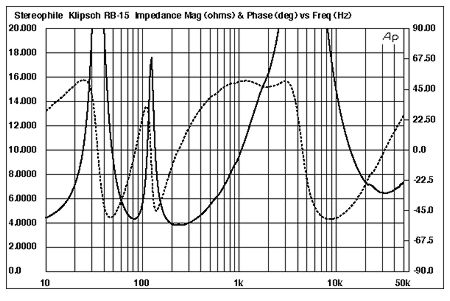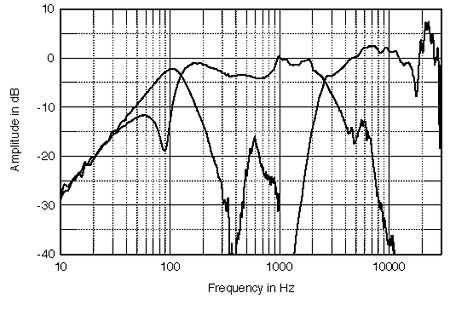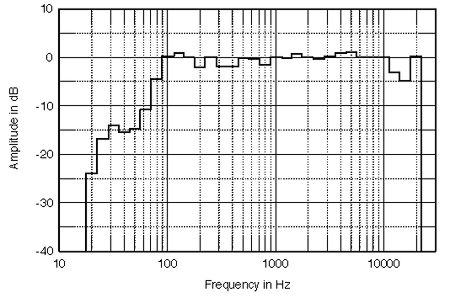| Columns Retired Columns & Blogs |
Klipsch RB-15 loudspeaker Measurements
Sidebar 3: Measurements
Despite its diminutive dimensions, the RB-15 offered above-average sensitivity, at an estimated 90dB(B)/2.83V/m. Though this is slightly below the specified figure of 93dB, it is still very respectable, particularly when you take into consideration the fact that the Klipsch's impedance stays above 6 ohms for most of the audioband (fig.1). It drops to around 4 ohms in just two regions—around 80Hz, the port tuning frequency; and in the lower midrange—and though the electrical phase angle is quite high at times, this is always when the impedance magnitude is high, mitigating any negative effects. The speaker will therefore be well-suited to being driven by inexpensive amplifiers and receivers.

Fig.1 Klipsch RB-15, electrical impedance (solid) and phase (dashed). (2 ohms/vertical div.)
Other than just above 20kHz, where the tweeter's dome resonance lies, the impedance traces look relatively free from the glitches that would indicate the presence of resonances. Nevertheless, I was bothered in my auditioning by what appeared to be a lively cabinet. Fig.2 is a cumulative spectral-decay plot calculated from the output of an accelerometer fastened to the top panel. A very strong mode can be seen at 563Hz, with the entire region between 100Hz and 300Hz acoustically active. Here, I believe, is the reason for the lower-midrange coloration and unevenness I noted.

Fig.2 Klipsch RB-15, cumulative spectral-decay plot calculated from the output of an accelerometer fastened to the cabinet's top panel. (MLS driving voltage to speaker, 7.55V; measurement bandwidth, 2kHz.)
Fig.3 shows, from left to right, the individual responses of the port, woofer, and tweeter. The port's maximum output occurs a little higher than the woofer's minimum-motion point, which lies at 88Hz, and the port has some midrange peakiness in its response. The port and woofer both visually benefit from the nearfield measurement technique, which boosts the upper bass by around 3dB; the woofer's somewhat depressed midrange in the farfield is real, however, when compared with its slightly elevated output in the region below its crossover to the tweeter. This occurs as specified just below 3kHz, with steep acoustic slopes apparent. The tweeter's on-axis response shelves up by a couple of dB between 5kHz and 12kHz, while there is a series of peaks between 19kHz and 29kHz, presumably due to the tweeter dome's breakup modes.

Fig.3 Klipsch RB-15, acoustic crossover on tweeter axis at 50", corrected for microphone response, with nearfield responses of the woofer and port plotted below 350Hz and 1kHz, respectively.
Fig.4 shows how these individual outputs add in the farfield, averaged across a ±15 degrees horizontal window on the tweeter axis. The mid- and low bass are missing in action, and, as noted earlier, the measured bump in the upper bass is going to be partly due to the nearfield technique. However, the RB-15's low-frequency alignment is on the generous side, which will both make the speaker sound a little bigger than it is and better balance the high frequencies. Although these are shelved up compared with the lower midrange, the overall treble balance is relatively even.

Fig.4 Klipsch RB-15, anechoic response on tweeter axis at 50", averaged across 30 degrees horizontal window and corrected for microphone response, with the complex sum of the nearfield woofer and port responses, taking into account acoustic phase and distance from the nominal farfield point, plotted below 300Hz.
The Klipsch's lateral dispersion is shown in fig.5. The speaker is a little more directional in the low treble than I was expecting, but the contour lines in this region are uniformly spaced, with no off-axis "hot spots." A deep notch develops at 12kHz to the speaker's sides, and the dispersion in the top audio octave is narrower than usual. In the vertical plane (fig.6), deep suckouts develop in the crossover region for axes more than 5 degrees below and 10 degrees above the tweeter axis. The stands used with the RB-15 should be tall enough to place the listener's ears pretty much on the tweeter axis. Other than the missing bass frequencies, a slightly shelved-down midrange, and a very slightly elevated presence region, the RB-15's spatially averaged in-room response (fig.7) is extraordinarily flat.

Fig.5 Klipsch RB-15, lateral response family at 50", normalized to response on tweeter axis, from back to front: differences in response 90 degrees-5 degrees off-axis, reference response, differences in response 5 degrees-90 degrees off-axis.

Fig.6 Klipsch RB-15, vertical response family at 50", normalized to response on tweeter axis, from back to front: differences in response 45 degrees-5 degrees above axis, reference response, differences in response 5 degrees-45 degrees below axis.

Fig.7 Klipsch RB-15, spatially averaged, 1/3-octave response in JA's listening room.
Despite the tweeter's physical setback, the RB-15 is not coincident, its step response (fig.8) revealing that the tweeter output arrives at the measuring microphone about 100;us before the woofer's. Other than a slight ridge of resonant energy at 4.7kHz—possibly a breakup mode in the woofer's metal cone—the RB-15's waterfall plot (fig.9) is very clean. This is commendable for such an inexpensive speaker.—John Atkinson

Fig.8 Klipsch RB-15, step response on tweeter axis at 50" (5ms time window, 30kHz bandwidth).

Fig.9 Klipsch RB-15, cumulative spectral-decay plot at 50" (0.15ms risetime).
- Log in or register to post comments




































